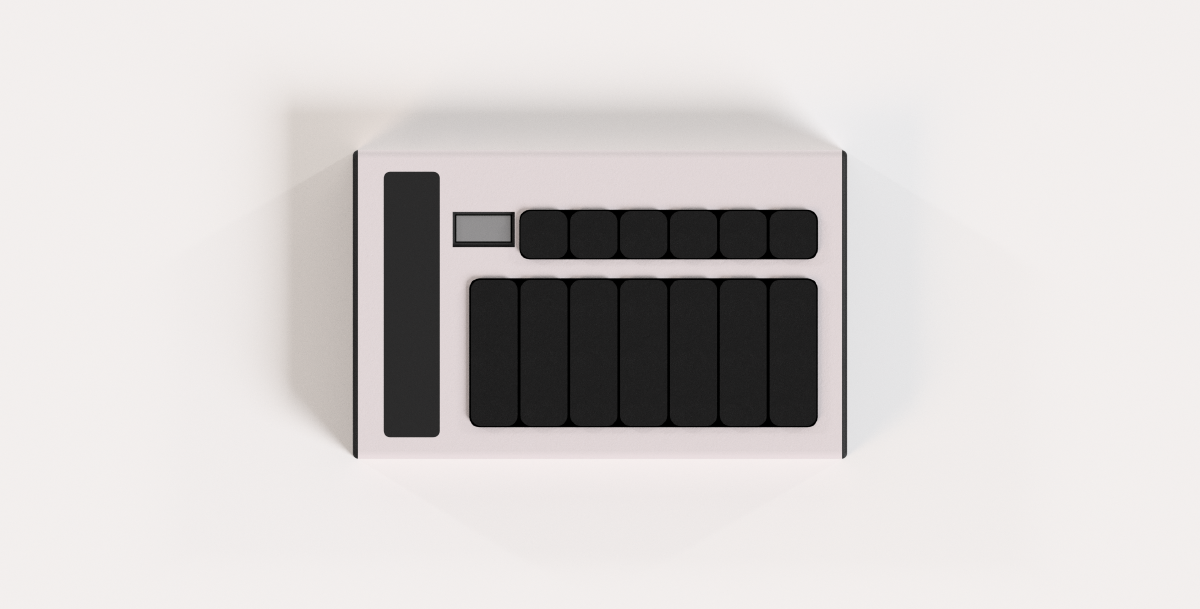Frequently Asked Questions
What is Touchord?
Touchord is an open source MIDI controller made for makers and musicians. Its main purpose is to simplify playing and composing by generating chords, modified via the touch bar.
Do you need any special software to play with Touchord?
No. Touchord uses a class-compliant USB MIDI protocol, which works with any DAW or computer software without drivers. For hardware synths, it supports a switchable Type A/B TRS connector.
Does it make the sound itself?
No. Touchord is purely a MIDI controller. To produce sound, you need a synthesizer or a software instrument on a computer.
What do the buttons do?
The top six buttons control Touchord:
- First button: switch playing mode
- Next two (-/+) buttons: change octaves & navigate menus
- Last three: assignable shortcut keys for quick key changes
The bottom seven keys are used for actual playing, each mapped to a chord in the selected key.
Why choose Touchord over alternatives?
Touchord was created as a passion project out of frustration with costly, closed-source alternatives.
- Many commercial devices are expensive, closed-source, and unreliable long-term.
- Closed-source products risk becoming e-waste if the company stops supporting them.
- Many include internal synths you may not need.
Touchord fixes these issues by being open source, affordable, hackable, and repairable.
I cannot play instruments. How does it benefit me?
Touchord requires minimal skill or theory. Simply choose a key, and each button plays a chord that fits. Even pressing random chords can sound good together.
I am a home musician playing covers. How does it benefit me?
Touchord’s Strum mode (similar to Omnichord) lets you strum the touch bar with a lush synth plugin for sounds not achievable on guitar or piano.
I am a producer. How does it benefit me?
Touchord speeds up harmony and chord exploration:
- Choose a key
- Adjust chord quality with the touch bar
- Quickly switch to parallel keys
- Experiment without memorizing theory
It’s a time-saving composition tool.
I am a performing musician. How does it benefit me?
If you sing or play live:
- Performance mode: play set chords instantly, control expression with the touch bar
- Strum mode: create layered textures a guitar or piano can’t produce
I am a professional musician. How does it benefit me?
If you already master theory, Touchord may not improve workflow. For you, it’s main value is the strum function for harp-like or layered textures.
I am a maker or electronics hobbyist. How does it benefit me?
Every part is open source:
- Print and assemble with your own 3D printer
- Modify PCB, firmware, or case
- Access points for hacking, upgrading, and experimenting
It’s designed for tinkerers.
Where and how is Touchord made?
Touchord is designed and hand-assembled in Lithuania, Europe, by a single developer.
When will and where Touchord be available for purchase?
If funding is successful, Q1 of 2026 would be a reasonable time frame. You will be able to pre-purchase Touchord for a lesser price on out IndieGoGO campaign, while funding the project itself.
Is the firmware upgradeable?
Yes. Enter bootloader mode via button combo, then drag & drop firmware files into Touchord’s USB storage to flash.
Why is it open source?
- Users can modify or extend firmware/hardware.
- Alternative firmware can be developed with common toolchains.
- If support ends, the community can continue development.
- Hardware uses standard components (RP2350 MCU, SSD1603 OLED, Cherry MX switches).
- Cases are 3D-printable and replaceable.
Openness ensures longevity and adaptability.
How customizable is Touchord?
- Keys: standard Cherry MX switches + plate-mounted stabilizers
- MCU: RP2350, programmable with PicoSDK, MicroPython, CircuitPython
- Expansion: 2× I²C connectors (with flipped pin versions), 10 GPIO pins exposed
- Fully reflashable firmware
Why does it have 3D printed components?
Injection molding is costly. Instead:
- 3D printing makes self-repair possible
- Makers can reprint/modify parts
- PETG composite provides strength, elasticity, and durability
Are 3D printed parts low quality?
No. PETG prints are strong, temperature-resistant, stable, and used in professional products (e.g., Prusa printers).
The Touchord’s solid frame eliminates weakness along layer lines.
Why use the Bela Trill Bar?
The Bela Trill Bar is:
- Open source and replaceable
- Readily available for makers
- Future-proof (others can manufacture if discontinued)
Why is only the sofware available on GitHub at the moment?
The software changes frequently through iterative development and bug fixes, so keeping its source in a Git repository is essential. Publishing it on GitHub honors the Open Source commitment and enables contributions, issue tracking, and transparent history.
Hardware and the 3D‑printed case evolve in larger, prototype-driven steps. Sharing unfinished designs would be misleading and could encourage unreliable builds; they will be released once the designs are stable and polished.
How long will Touchord be supported?
As long as orders and funding cover costs, development will continue with iterative improvements. If sustainability fails, its open-source license ensures others can fork, improve, or revive the project independently.

